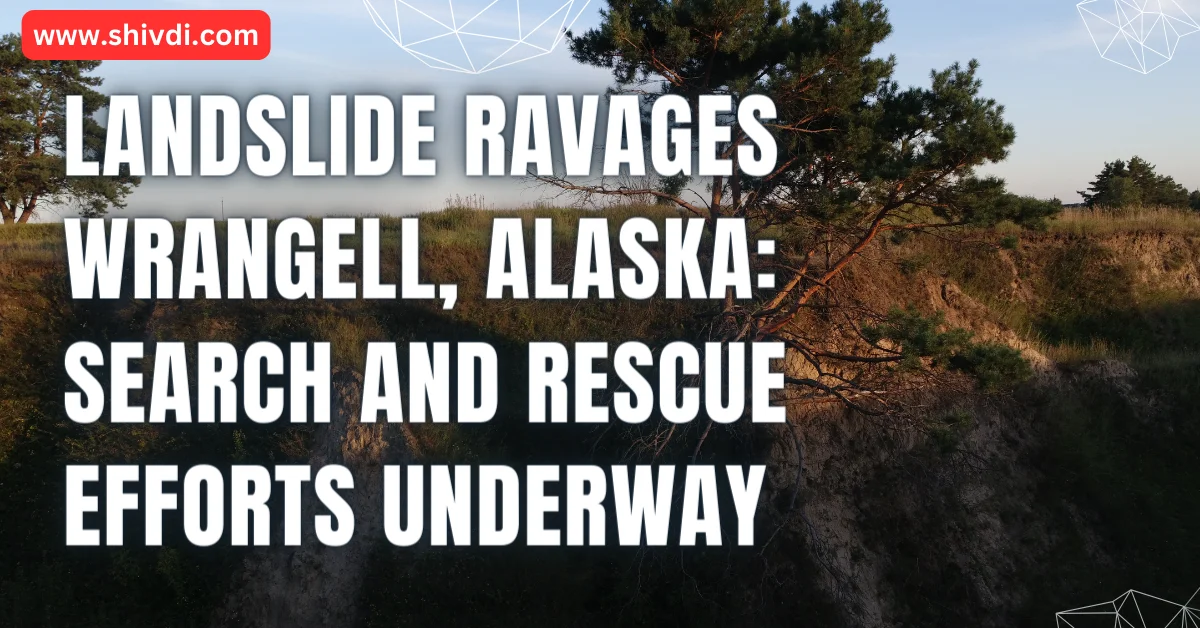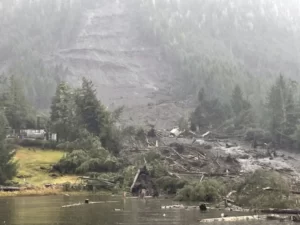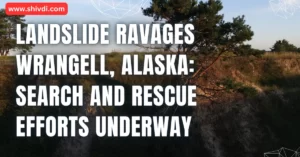A massive landslide tore through Wrangell, Alaska, leaving a trail of destruction and prompting a multi-agency search and rescue operation. Read more to learn about …, and the ongoing efforts to locate and assist those affected by the disaster.
Landslide Ravages Wrangell, Alaska: A Community in Peril
On a seemingly unremarkable day in the heart of Alaska’s pristine wilderness, a catastrophic landslide tore through the tranquil town of Wrangell, leaving a trail of devastation in its wake. The earth-shattering event, triggered by a combination of heavy rainfall and seismic activity, unleashed a torrent of rocks, mud, and debris, transforming the once peaceful landscape into a scene of utter chaos.
Nestled amidst the towering peaks of the Wrangell-St. Elias National Park, Wrangell, a picturesque town of just over 2,000 residents, found itself thrust into the face of nature’s fury. The landslide, estimated to have moved at a terrifying speed of over 100 miles per hour, engulfed everything in its path, leaving behind a trail of shattered homes, uprooted trees, and unrecognizable landmarks.
The immediate aftermath was shrouded in an atmosphere of disbelief and despair. The thunderous roar of the landslide had echoed through the valley, leaving residents stunned and terrified. As the dust settled, the true extent of the damage became clear, and the urgency of a search and rescue operation reached a fever pitch.
With lives hanging in the balance, a multi-agency task force, comprising local authorities, state and federal agencies, and volunteer organizations, sprang into action. The race against time was on, and the fate of Wrangell hung precariously in the balance.
Landslide Details: Unraveling the Unseen Forces
The landslide that struck Wrangell, Alaska, was a colossal event, leaving an indelible mark on the landscape and the lives of its residents. Its sheer size and destructive power were staggering, leaving behind a scene of devastation that defied description.
Size and Scope of the Landslide
The landslide, estimated to have moved at a speed of over 100 miles per hour, spanned an area of approximately 100 acres, originating from a mountainside near the Stikine River. The sheer mass of material involved, estimated to be millions of cubic yards, unleashed a force that reshaped the terrain, leaving behind a trail of debris that stretched for over a mile.
Location and Time of Occurrence
The landslide struck the Stikine River delta, approximately five miles from the town of Wrangell. Its exact time of occurrence remains unclear, with estimates placing it between the late evening of October 4 and the early morning hours of October 5.
Potential Causes of the Landslide
The exact causes of the landslide are still being investigated, but heavy rainfall and seismic activity are considered to be the primary contributing factors. The region had experienced significant rainfall in the days leading up to the landslide, saturating the soil and increasing the likelihood of instability. Additionally, the area is seismically active, with a history of earthquakes that could have triggered the landslide.
Initial Damage Assessment
The initial assessment of damage caused by the landslide was grim. Numerous homes and structures were destroyed or severely damaged, and infrastructure, including roads and power lines, was severely disrupted. The landslide also caused significant environmental damage, disrupting the delicate balance of the Stikine River delta ecosystem.
Search and Rescue Operations: A Race Against Time and Peril
In the aftermath of the devastating landslide that struck Wrangell, Alaska, a multi-agency search and rescue operation was swiftly mobilized, driven by an unwavering commitment to locate and assist those affected by the disaster. The operation, a testament to the resilience and unity of the Alaskan community, faced a multitude of challenges, yet pressed on with unwavering determination.
Multi-Agency Collaboration
Recognizing the magnitude of the disaster, a coalition of agencies joined forces to form a unified response team. Local authorities, state and federal agencies, and volunteer organizations came together, pooling their resources and expertise to tackle the daunting task ahead.
Hazardous Conditions and Limited Visibility
Rescue teams faced a formidable array of challenges, including unstable terrain, treacherous weather conditions, and limited visibility. The landslide had left behind a landscape riddled with hazards, with loose rocks, mudslides, and debris posing a constant threat to rescuers. Heavy rainfall and fog further hampered visibility, obscuring potential hazards and making the search process even more perilous.
Unwavering Determination and Progress
Despite the daunting challenges, the search and rescue operation continued relentlessly. Teams worked tirelessly, employing a combination of ground searches, aerial surveillance, and advanced technology to locate survivors. Their efforts were fueled by an unwavering belief that every minute counted, and that lives could be saved with every passing moment.
Updates on the Search and Rescue Operation
As the search and rescue operation progressed, updates were regularly provided to the public. These updates detailed the progress made, the challenges encountered, and any new information regarding the whereabouts of potential survivors. The community held its breath, anxiously awaiting news of their loved ones.
A Beacon of Hope Amidst Devastation
The search and rescue operation served as a beacon of hope amidst the devastation. It demonstrated the unwavering commitment of the Alaskan community to stand together in the face of adversity, and to work tirelessly to bring those affected back to safety. As the operation continued, the community rallied around the rescue teams, providing support and encouragement through acts of kindness and solidarity.
Impact on Wrangell
A Community Unyielding in the Face of Adversity
The massive landslide that struck Wrangell, Alaska, left an indelible mark on the town, leaving a trail of destruction that shattered homes, disrupted infrastructure, and threatened livelihoods. Yet, amidst the chaos and despair, the spirit of Wrangell’s residents shone through, demonstrating an unwavering resilience and a profound sense of community.
Loss of Homes and Infrastructure
The landslide’s destructive force wreaked havoc on Wrangell’s residential neighborhoods. Numerous homes were either completely destroyed or rendered uninhabitable, leaving families displaced and facing an uncertain future. The loss of homes extended beyond physical structures; it represented the loss of memories, cherished possessions, and the sense of security that comes with a stable home environment.
The landslide also caused significant damage to Wrangell’s infrastructure, disrupting essential services and hindering daily life. Roads were blocked, power lines were severed, and communication networks were crippled. These disruptions posed additional challenges for residents, making it difficult to access essential services, communicate with loved ones, and navigate the aftermath of the disaster.
Economic Disruption and Livelihood Loss
The landslide’s impact extended beyond homes and infrastructure, reaching into the economic heart of Wrangell. Businesses were forced to close, tourism took a significant hit, and many residents found themselves without a source of income. The economic fallout was swift and severe, adding to the already immense burden faced by the community.
Stories of Resilience and Support
In the face of adversity, the spirit of Wrangell’s residents shone through. Stories of resilience, compassion, and selflessness emerged from the depths of despair, demonstrating the unwavering strength of the community.
Neighbors came together to provide shelter, food, and emotional support to those affected by the landslide. Volunteers organized donation drives and community events to raise funds for relief efforts. The town’s businesses, though facing their own challenges, stepped up to offer discounts, donate supplies, and provide employment opportunities to those who had lost their livelihoods.
The landslide tested the very fabric of Wrangell’s community, but it also revealed the profound strength that lay at its core. In the face of devastation, the people of Wrangell came together, offering support, sharing resources, and demonstrating an unwavering belief in their ability to rebuild and recover.
Road Closures and Public Safety
The landslide has caused significant road closures in the Wrangell area. Please be aware of the following road closures and avoid the affected area:
- Front St: Closed between Main St and Forest St.
- Stikine Ave: Closed between Mill St and Forest St.
- Mill St: Closed between Front St and Stikine Ave.
- Forest St: Closed between Front St and Stikine Ave.
Please adhere to all road closure warnings and avoid the affected area to allow emergency responders to access the area and continue their work.
The Alaska Department of Transportation is working to reopen the roads as soon as possible. In the meantime, please use the following alternative travel routes:
- To travel from downtown Wrangell to the airport: Take Airport Rd to Stikine Ave, then turn left onto Mill St. Follow Mill St to Front St, then turn right onto Front St. Continue on Front St to Airport Rd.
- To travel from the airport to downtown Wrangell: Take Airport Rd to Front St, then turn left onto Mill St. Follow Mill St to Stikine Ave, then turn right onto Stikine Ave. Continue on Stikine Ave to Airport Rd.
Please check the Alaska Department of Transportation website for the latest updates on road closures and alternative travel routes.
I will continue to monitor the situation and provide updates as they become available.




















